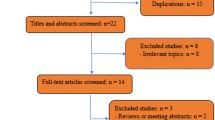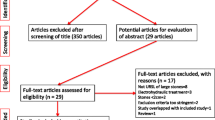Abstract
Purpose
To compare the efficacy and safety of different treatment options for the management of proximal impacted ureteral stones (PIUS).
Methods
A systematic literature search using Pubmed, Medline, Embase and Cochrane Library was conducted to obtain studies concerning different managements for PIUS up to Jan 2018. Summary odds ratios (ORs), standard mean differences (SMDs) or weighted mean differences with their 95% confidence intervals (CIs) were calculated to compare the efficacy and safety of all included treatment methods, registered in PROSPERO under number CRD42018092745.
Results
A total of 15 comparative studies with 1780 patients were included. Meta-analyses of final stone-free rate (SFR) favored percutaneous nephrolithotomy (PCNL) over ureteroscopic lithotripsy (URL) (OR 10.35; 95% CI 5.26–20.35; P < 0.00001), laparoscopic ureterolithotomy over URL (OR 0.11; 95% CI 0.05–0.25; P < 0.00001) and URL over extracorporeal shockwave lithotripsy (OR 0.47; 95% CI 0.28–0.77; P = 0.003). As to complications, PCNL had a significantly higher blood transfusion rate (OR 7.47; 95% CI 1.3–42.85; P = 0.02) and a lower ureteral injury rate (OR 0.15; 95% CI 0.04–0.52; P = 0.003) compared with URL. It also shared a significantly lower stone-retropulsion rate (OR 0.03; 95% CI 0.01–0.15; P < 0.0001) and higher treatment costs (SMD = 2.71; 95% CI 0.71–4.70; P = 0.008) than URL.
Conclusions
Our meta-analysis suggested that PCNL might be the best option for PIUS owing to its higher successful rate. Complications such as hemorrhage could be decreased by the application on mini-PCNL.








Similar content being viewed by others
References
Sinha M, Kekre NS, Chacko KN, Devasia A, Lionel G, Pandey AP, Gopalakrishnan G (2004) Does failure to visualize the ureter distal to an impacted calculus constitute an impediment to successful lithotripsy? J Endourol 18:431–435
Wang Y, Zhong B, Yang X, Wang G, Hou P, Meng J (2017) Comparison of the efficacy and safety of URSL, RPLU, and MPCNL for treatment of large upper impacted ureteral stones: a randomized controlled trial. BMC Urol 17:50
Liu Y, Zhou Z, Xia A, Dai H, Guo L, Zheng J (2013) Clinical observation of different minimally invasive surgeries for the treatment of impacted upper ureteral calculi. Pak J Med Sci 29:1358–1362
Qi S, Li Y, Liu X, Zhang C, Zhang H, Zhang Z, Xu Y (2014) Clinical efficacy, safety, and costs of percutaneous occlusive balloon catheter-assisted ureteroscopic lithotripsy for large impacted proximal ureteral calculi: a prospective, randomized study. J Endourol 28:1064–1070
Topaloglu H, Karakoyunlu N, Sari S, Ozok HU, Sagnak L, Ersoy H (2014) A comparison of antegrade percutaneous and laparoscopic approaches in the treatment of proximal ureteral stones. Biomed Res Int 2014:691946
Shao Y, Wang DW, Lu GL, Shen ZJ (2015) Retroperitoneal laparoscopic ureterolithotomy in comparison with ureteroscopic lithotripsy in the management of impacted upper ureteral stones larger than 12 mm. World J Urol 33:1841–1845
Khalil M (2013) Management of impacted proximal ureteral stone: extracorporeal shock wave lithotripsy versus ureteroscopy with holmium: YAG laser lithotripsy. Urol Ann 5:88–92
Gao ZM, Gao S, Qu HC, Li K, Li N, Liu CL, Zhu XW, Liu YL, Wang P, Zheng XH (2017) Minimally invasive percutaneous nephrolithotomy improves stone-free rates for impacted proximal ureteral stones: a systematic review and meta-analysis. PLoS One 12:e0171230
Türk C, Neisius A, Petrik A et al. (2017) European Association of Urology guidelines on urolithiasis 2017. Available at: http://uroweb.org/guideline/urolithiasis/. Accessed 20 June 2017
Wolf JS, Bennett CJ, Dmochowski RR et al. (2016) Best practice policy statement on urologic surgery antimicrobial prophylaxis 2016. Available at: http://www.auanet.org/guidelines/antimicrobial-prophylaxis. Accessed 20 June 2017
Liberati A, Altman DG, Tetzlaff J, Mulrow C, Gøtzsche PC, Ioannidis JP, Clarke M, Devereaux PJ, Kleijnen J, Moher D (2009) The PRISMA statement for reporting systematic reviews and meta-analyses of studies that evaluate healthcare interventions: explanation and elaboration. BMJ 339:b2700
Kurahashi N, Iwasaki M, Sasazuki S, Otani T, Inoue M, Tsugane S (2007) Soy product and isoflavone consumption in relation to prostate cancer in Japanese men. Cancer Epidemiol Biomark Prev 16:538–545
Stang A (2010) Critical evaluation of the Newcastle-Ottawa scale for the assessment of the quality of nonrandomized studies in meta-analyses. Eur J Epidemiol 25:603–605
Higgins JP, Altman DG, Gøtzsche PC, Jüni P, Moher D, Oxman AD, Savovic J, Schulz KF, Weeks L, Sterne JA (2011) The cochrane collaboration’s tool for assessing risk of bias in randomised trials. BMJ 343:d5928
Egger M, Davey Smith G, Schneider M, Minder C (1997) Bias in meta-analysis detected by a simple, graphical test. BMJ 315:629–634 (Clinical research ed)
Gu XJ, Lu JL, Xu Y (2013) Treatment of large impacted proximal ureteral stones: randomized comparison of minimally invasive percutaneous antegrade ureterolithotripsy versus retrograde ureterolithotripsy. World J Urol 31:1605–1610
Li H, Na W, Li H, Jiang Y, Gu X, Zhang M, Huo W, Kong X (2013) Percutaneous nephrolithotomy versus ureteroscopic lithotomy for large (> 15 mm) impacted upper ureteral stones in different locations: is the upper border of the fourth lumbar vertebra a good indication for choice of management method. J Endourol 27:1120–1125
Moufid K, Abbaka N, Touiti D, Adermouch L, Amine M, Lezrek M (2013) Large impacted upper ureteral calculi: a comparative study between retrograde ureterolithotripsy and percutaneous antegrade ureterolithotripsy in the modified lateral position. Urol Ann 5:140–146
Yang Z, Song L, Xie D et al (2012) Comparative study of outcome in treating upper ureteral impacted stones using minimally invasive percutaneous nephrolithotomy with aid of patented system or transurethral ureteroscopy. Urology 80:1192–1197
Juan YS, Shen JT, Li CC, Wang CJ, Chuang SM, Huang CH, Wu WJ (2008) Comparison of percutaneous nephrolithotomy and ureteroscopic lithotripsy in the management of impacted, large, proximal ureteral stones. Kaohsiung J Med Sci 24:204–209
Sun X, Xia S, Lu J, Liu H, Han B, Li W (2008) Treatment of large impacted proximal ureteral stones: randomized comparison of percutaneous antegrade ureterolithotripsy versus retrograde ureterolithotripsy. J Endourol 22:913–917
Jiang JT, Li WG, Zhu YP et al (2016) Comparison of the clinical efficacy and safety of retroperitoneal laparoscopic ureterolithotomy and ureteroscopic holmium laser lithotripsy in the treatment of obstructive upper ureteral calculi with concurrent urinary tract infections. Lasers Med Sci 31:915–920
Ziaee SA, Basiri A, Nadjafi-Semnani M, Zand S, Iranpour A (2006) Extracorporeal shock wave lithotripsy and transureteral lithotripsy in the treatment of impacted lower ureteral calculi. Urol J 3:75–78
Wu CF, Shee JJ, Lin WY, Lin CL, Chen CS (2004) Comparison between extracorporeal shock wave lithotripsy and semirigid ureterorenoscope with holmium: YAG laser lithotripsy for treating large proximal ureteral stones. J Urol 172:1899–1902
Li BJ (2012) Progression of minimally invasive therapy for upper ureteral calculi. Chin J New Clin Med 5:267–270
Barakat TS, El-Nahas AR, Shoma AM, Shokeir AA (2013) Ureteroscopy for upper ureteral stones: overcoming the difficulties of the rigid approach. Diffic Cases Endourol 10:211–223
Mugiya S, Ozono S, Nagata M, Takayama T, Nagae H (2006) Retrograde endoscopic management of ureteral stones more than 2 cm in size. Urology 67:1164–1168
Ramakumar S, Segura JW (2001) When not to use shock wave lithotripsy for ureteral stones. Contemp Urol 13:54–65
Lam JS, Greene TD, Gupta M (2002) Treatment of proximal ureteral calculi: holmium: YAG laser ureterolithotripsy versus extracorporeal shock wave lithotripsy. J Urol 167:1972–1976
Preminger GM, Tiselius HG, Assimos DG et al (2007) 2007 guideline for the management of ureteral calculi. J Urol 178:2418–2434
el-Nahas AR, Eraky I, el-Assmy AM et al (2006) Percutaneous treatment of large upper tract stones after urinary diversion. Urology 68:500–504
Karami H, Arbab AH, Hosseini SJ, Razzaghi MR, Simaei NR (2006) Impacted upper-ureteral calculi > 1 cm: blind access and totally tubeless percutaneous antegrade removal or retrograde approach? J Endourol 20:616–619
Osman M, Wendt-Nordahl G, Heger K, Michel MS, Alken P, Knoll T (2005) Percutaneous nephrolithotomy with ultrasonography-guided renal access: experience from over 300 cases. BJU Int 96:875–878
Legemate JD, Wijnstok NJ, Matsuda T et al (2017) Characteristics and outcomes of ureteroscopic treatment in 2650 patients with impacted ureteral stones. World J Urol 35:1497–1506
Mishra S, Sharma R, Garg C, Kurien A, Sabnis R, Desai M (2011) Prospective comparative study of miniperc and standard PNL for treatment of 1 to 2 cm size renal stone. BJU Int 108:896–900
Zhu W, Liu Y, Liu L, Lei M, Yuan J, Wan SP, Zeng G (2015) Minimally invasive versus standard percutaneous nephrolithotomy: a meta-analysis. Urolithiasis 43:563–570
Sarica K, Kafkasli A, Yazici Ö et al (2015) Ureteral wall thickness at the impacted ureteral stone site: a critical predictor for success rates after SWL. Urolithiasis 43:83–88
Yoshida T, Inoue T, Omura N et al (2017) Ureteral wall thickness as a preoperative indicator of impacted stones in patients with ureteral stones undergoing ureteroscopic lithotripsy. Urology 106:45–49
Elibol O, Safak KY, Buz A, Eryildirim B, Erdem K, Sarica K (2017) Radiological noninvasive assessment of ureteral stone impaction into the ureteric wall: a critical evaluation with objective radiological parameters. Investig Clin Urol 58:339–345
Deliveliotis C, Chrisofos M, Albanis S, Serafetinides E, Varkarakis J, Protogerou V (2003) Management and follow-up of impacted ureteral stones. Urol Int 70:269–272
Sahin C, Eryildirim B, Kafkasli A et al (2015) Predictive parameters for medical expulsive therapy in ureteral stones: a critical evaluation. Urolithiasis 43:271–275
Yoshida T, Inoue T, Taguchi M, Omura N, Kinoshita H, Matsuda T (2018) Ureteral wall thickness as a significant factor in predicting spontaneous passage of ureteralstones of ≤ 10 mm: a preliminary report. World J Urol. https://doi.org/10.1007/s00345-018-2461-x
Tuerxun A, Batuer A, Erturhan S, Eryildirim B, Camur E, Sarica K (2017) Impaction and prediction: does ureteral wall thickness affect the success of medical expulsive therapy in pediatric ureteral stones? Urol Int 98:436–441
Acknowledgements
This study was financed by Grants from the Natural Science Foundation of Guangdong Province (No. 2017A030310547), China Postdoctoral Science Foundation (No. 2018T110859, No. 2017M612636 and No. 2017M622912), National Natural Science Foundation of China (No. 81802821 and No. 81670643), the Collaborative Innovation Project of Guangzhou Education Bureau (No. 1201620011) the Guangzhou Science Technology and Innovation Commission (No. 201604020001 and No. 201704020193), and the Science and Technology Planning Project of Guangdong Province (No. 2017B030314108).
Author information
Authors and Affiliations
Contributions
TD: project development, data collection, data analysis, and manuscript writing; YC: data collection, data analysis, and manuscript writing; BL: data collection, data analysis, and manuscript writing; MPL: manuscript editing; JJMCHdlR: manuscript editing; XD: manuscript editing; WW: manuscript editing; GZ: project development and manuscript editing.
Corresponding author
Ethics declarations
Conflict of interest
The authors declare that they have no conflicts of interest.
Ethical approval
No ethical approval was necessary due to its exclusive use of secondary data.
Rights and permissions
About this article
Cite this article
Deng, T., Chen, Y., Liu, B. et al. Systematic review and cumulative analysis of the managements for proximal impacted ureteral stones. World J Urol 37, 1687–1701 (2019). https://doi.org/10.1007/s00345-018-2561-7
Received:
Accepted:
Published:
Issue Date:
DOI: https://doi.org/10.1007/s00345-018-2561-7




